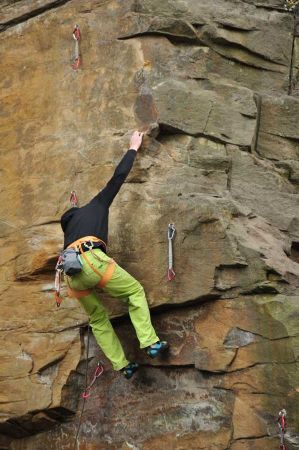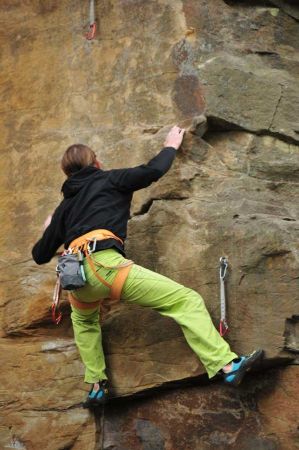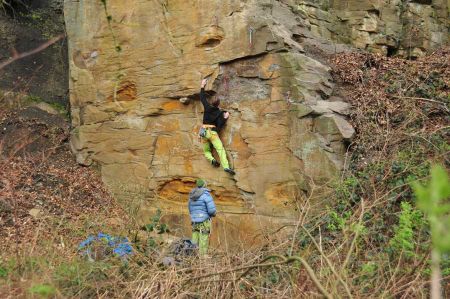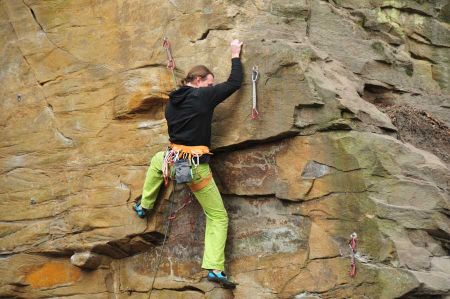Climbing in the Ruhr area – next to the castle ruins Hardenstein
- Written by Portal Editor
Climbing has been in for many years. And the hype is continuing - and this is reflected in the number of climbing opportunities in the Ruhr area, too.
We had visited the castle ruins Hardenstein when we encountered some climbers on the rocks of the area. What makes climbing so popular is the low inhibition threshold: Anyone can climb, and beginners need nothing more than their urge to move up the many full-service climbing gyms. In Boulder Halls the hurdle is even lower: here it does not even need belt and rope. And one thing is the same with all people: climbing a mountain on your own strength just makes you happy, increases your self-confidence and you are out in nature!
Climbing is traditionally practiced in the wild, and as the rocks often host sensitive ecosystems, as the sport's popularity increases, there is a conflict between the needs of climbers and those of environmentalists. Representatives of nature conservation point out that the rocks often form sensitive biotopes and are home to rare plants and animals (especially birds). The environmental aspect should be given priority and the recovery interest of climbers must withdraw behind in case of doubt. In extreme cases, the opinion is voiced that climbing should only be done on artificial plants in order to preserve nature as much as possible.
Is climbing in nature and environmental protection compatible?
 In order to prevent the negative effects of climbing sport on nature, climbing concepts have been developed by the IG Climbing and other associations for most areas, which mostly restrict climbing on a small scale based on voluntary regulations in such a way that consideration is given to plant and animal welfare. Many people are of the opinion that environmental protection and climbing are compatible with the climbers with relatively little restrictions. It is precisely the exercise of sport in the wild that promotes a bond with nature and the interest in preserving it. When introducing environmental protection measures, one should think about the interests of the climbers. Overall, climbing should be regulated as little as possible, and necessary restrictions (such as the blocking of rocks) should be reduced to a minimum. In Bavaria, a corresponding procedure for the creation of climbing concepts between IG climbing, DAV and authorities is contractually regulated.
In order to prevent the negative effects of climbing sport on nature, climbing concepts have been developed by the IG Climbing and other associations for most areas, which mostly restrict climbing on a small scale based on voluntary regulations in such a way that consideration is given to plant and animal welfare. Many people are of the opinion that environmental protection and climbing are compatible with the climbers with relatively little restrictions. It is precisely the exercise of sport in the wild that promotes a bond with nature and the interest in preserving it. When introducing environmental protection measures, one should think about the interests of the climbers. Overall, climbing should be regulated as little as possible, and necessary restrictions (such as the blocking of rocks) should be reduced to a minimum. In Bavaria, a corresponding procedure for the creation of climbing concepts between IG climbing, DAV and authorities is contractually regulated.
Climbing athletes are particularly troubled by rock-breeding bird species such as eagle owl and peregrine falcon. In the breeding season undisturbed rocks or quarries are vital for these species, which can reach to the independence of the boys from February to August. How severe the consequences of unregulated climbing sports in owl habitats can be in extreme cases is shown by the company's long-standing observations on the conservation of owls in the Eifel. In Thuringia between 1973 and 2015 at least 91 breeds were abandoned after disturbances by climbers. In order to solve this problem, numerous temporary closures have been agreed by IG Climbing and other associations during the breeding season of rare birds. In 2011, the Regensburg biologists Christoph Reisch and Frank Vogler came to the conclusion in a study that climbing sports had a negative effect on the seed dispersal of rare plants such as the Yellow Famine (Draba aozides) and also limited the genetic variability of the hunger flower on climbing rocks, on the part of the IG Climbing Basel it was doubted, because smooth, low-vegetation zones, which have less habitat possibilities, are better suited for climbing per se than brittle, overgrown areas.
Climbing bunker in Duisburg
 The climbing bunker offers 60 outdoor routes on a 770 m² climbing area. The artificial rock landscape is 16 meters high and offers enough space for beginners and professionals. The Bunker Wall consists of different structures and thus has different levels of difficulty. Inside there is a large boulder area, which leaves nothing to be desired! The Climbing Club Duisburg also offers various courses for beginners and children can even celebrate their birthday here.
The climbing bunker offers 60 outdoor routes on a 770 m² climbing area. The artificial rock landscape is 16 meters high and offers enough space for beginners and professionals. The Bunker Wall consists of different structures and thus has different levels of difficulty. Inside there is a large boulder area, which leaves nothing to be desired! The Climbing Club Duisburg also offers various courses for beginners and children can even celebrate their birthday here.
Climbing Bunker in Duisburg
Rudolph-Schock-Straße 10
47053 Duisburg
Tel .: 0176 84413216
Climbing garden in the landscape park Duisburg-Nord
At the foot of the incredible steel giants in the landscape park Duisburg-Nord, it is not only industrial-historical, but also sporty. In the ore bunker walls of the decommissioned Thyssen steelworks, the climbing friend will find on 7,000 square meters a climbing garden with over 400 routes up to 12 meters wall height of various difficulty levels, a via ferrata with 2 suspension bridges and a crampon climbing wall. There is a small boulder area. Different courses are offered and all in all, the climber here is Germany's largest outdoor climbing facility!
Climbing garden in the landscape park Duisburg-Nord
Emscherstr. 71
47137 Duisburg
Tel: 0203 428120
Climbing Solid
 As an indoor facility, the climbing massif offers everything a sports or hobby climber needs: on 1,200 square meters there are various climbing walls, for example an inclined climbing wall for friction climbing or children climbing, as well as training climbing walls from 8 to 14 meters in height.
As an indoor facility, the climbing massif offers everything a sports or hobby climber needs: on 1,200 square meters there are various climbing walls, for example an inclined climbing wall for friction climbing or children climbing, as well as training climbing walls from 8 to 14 meters in height.
About 200 routes can be climbed here.
In addition: courses for beginners and advanced, parenting safety instructions, children's birthday parties, adventure climbing for school classes, open climbing group for all without climbing partners with security knowledge and a cafeteria.
Climbing Solid
Wiesenstr. 76
40549 Dusseldorf-Heerdt
Tel: 0211 5638789
Climbing facility Nordstern
In Nordsternpark you can climb up to 16 meters on three artificial towers. On 1,070 m² there are about 500 inserts and more than 2500 screwed handles in more than 80 routes in the difficulty levels 3 to 9. Professionals will have their fun on the overhangs. The climbing facility is built and operated by the German Alpine Club, Gelsenkirchen section.
Climbing facility Nordstern
Nordstern colliery in Gelsenkirchen-Horst
At the Bugapark
0209-58 64 86 Olaf Basilowski
Please read as well:
Gdynia - sandy beaches and important business port
By bike along the bike path on the Hel Pininsula
-
 Climbing at Castle Ruin Hardenberg
Climbing at Castle Ruin Hardenberg
Climbing at Castle Ruin Hardenberg
Climbing at Castle Ruin Hardenberg
-
 Climbing at Castle Ruin Hardenberg
Climbing at Castle Ruin Hardenberg
Climbing at Castle Ruin Hardenberg
Climbing at Castle Ruin Hardenberg
-
 Climbing at Castle Ruin Hardenberg
Climbing at Castle Ruin Hardenberg
Climbing at Castle Ruin Hardenberg
Climbing at Castle Ruin Hardenberg
https://www.alaturka.info/en/germany/north-rhine-westphalia/4852-climbing-in-the-ruhr-area-next-to-the-castle-ruins-hardenstein#sigProIdeb17badf1c

